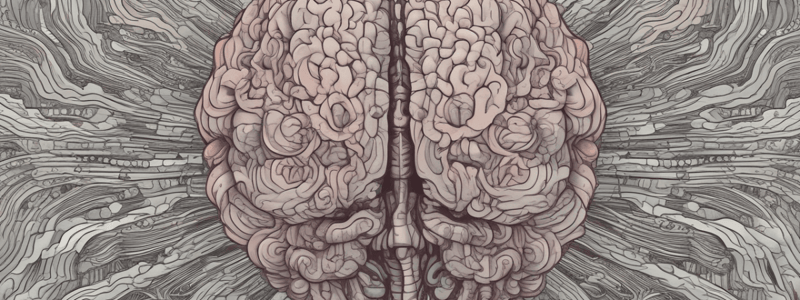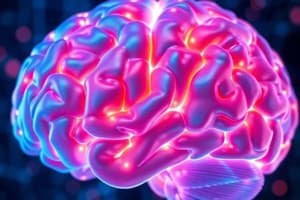Podcast
Questions and Answers
Neurons receive information through their ______.
Neurons receive information through their ______.
dendrites
The ______ is the information receiver in neural communication.
The ______ is the information receiver in neural communication.
postsynaptic neuron
The ______ matter consists of cell bodies.
The ______ matter consists of cell bodies.
gray
Raised surfaces of the cerebral cortex are called ______.
Raised surfaces of the cerebral cortex are called ______.
The ______ system is involved in motor control and skill learning.
The ______ system is involved in motor control and skill learning.
The ______ is the part of the brain involved in tissue repair and myelin formation.
The ______ is the part of the brain involved in tissue repair and myelin formation.
The ______ is the term for the outer regions of the brain.
The ______ is the term for the outer regions of the brain.
The ______ is the term for the central regions of the brain.
The ______ is the term for the central regions of the brain.
Sensation is the effects of ______ on sensory organs
Sensation is the effects of ______ on sensory organs
Rod cells are specialized for low ______ of light and movement
Rod cells are specialized for low ______ of light and movement
The Fovea is entirely made of ______ → visual acuity
The Fovea is entirely made of ______ → visual acuity
The blind spot is where the optic nerve leaves the ______
The blind spot is where the optic nerve leaves the ______
The Primary Visual Cortex (V1) is located in the ______ lobe, at the posterior of the brain
The Primary Visual Cortex (V1) is located in the ______ lobe, at the posterior of the brain
Simple cells respond to particular ______ and single points of light
Simple cells respond to particular ______ and single points of light
The Geniculostriate pathway is the best understood and makes the largest contribution to human ______ perception
The Geniculostriate pathway is the best understood and makes the largest contribution to human ______ perception
The pathway to suprachiasmatic nucleus in the hypothalamus provides information about the ______ of day
The pathway to suprachiasmatic nucleus in the hypothalamus provides information about the ______ of day
Hemianopia is cortical blindness restricted to one ______ of the visual field.
Hemianopia is cortical blindness restricted to one ______ of the visual field.
Quadrantanopia is cortical blindness restricted to a ______ of the visual field.
Quadrantanopia is cortical blindness restricted to a ______ of the visual field.
Achromatopsia is a failure to perceive ______ due to damage to V4.
Achromatopsia is a failure to perceive ______ due to damage to V4.
Akinetopsia is a failure to perceive visual ______ due to damage to V5.
Akinetopsia is a failure to perceive visual ______ due to damage to V5.
Blindsight is the inability to report perceiving visual stimulus even though ______ suggests otherwise.
Blindsight is the inability to report perceiving visual stimulus even though ______ suggests otherwise.
DB reported not seeing stimuli but oriented his eyes correctly toward stimuli, suggesting an ability to detect ______, motion, contrast.
DB reported not seeing stimuli but oriented his eyes correctly toward stimuli, suggesting an ability to detect ______, motion, contrast.
LM cannot detect direction of ______ but can detect biological motion
LM cannot detect direction of ______ but can detect biological motion
Object recognition involves the perception of basic ______ (e.g., edges of various lengths, contrasts & orientations)
Object recognition involves the perception of basic ______ (e.g., edges of various lengths, contrasts & orientations)
3D ______ of an object are stored in memory
3D ______ of an object are stored in memory
Agnosia is a failure in ______ recognition
Agnosia is a failure in ______ recognition
Apperceptive agnosia is a failure to recognize objects due to a deficit at the level of ______ perception
Apperceptive agnosia is a failure to recognize objects due to a deficit at the level of ______ perception
The parahippocampal place area (PPA) is an area of the brain that responds to ______ more than objects
The parahippocampal place area (PPA) is an area of the brain that responds to ______ more than objects
The fusiform face area (FFA) is an area in the inferior temporal lobes that responds more to ______ than other visual objects
The fusiform face area (FFA) is an area in the inferior temporal lobes that responds more to ______ than other visual objects
Prosopagnosia is an inability to recognize previously familiar ______
Prosopagnosia is an inability to recognize previously familiar ______
Study Notes
Introducing the Brain
- Neurons are cells that make up the nervous system, consisting of a cell body (soma), dendrites, and axon.
- The cell body contains the nucleus and organelles.
- Dendrites receive information, while the axon sends information.
Neural Communication
- Terminal buttons of a neuron and dendrites of another neuron communicate through a small gap called a synapse.
- Presynaptic neuron is the information giver, while postsynaptic neuron is the information receiver.
- Action potential electrically charges the presynaptic neuron, inducing the release of informative chemicals called neurotransmitters.
Terms of Directional References
- Lateral: refers to the outer regions of the brain.
- Medial: refers to the central regions of the brain.
Gross Organization of the Brain
- Gray matter consists of cell bodies.
- White matter consists of axons and glia (support cells involved in tissue repair and myelin formation).
Cerebral Cortex
- Folded sheets of gray matter.
- Raised surfaces are called gyri (gyrus).
- Folds are called sulci (sulcus).
- The folded structure helps to increase area/volume ratio (efficiency in packaging of the brain).
4 Main Parts of the Cerebral Cortex
- No specific information provided about the 4 main parts.
Subcortex
- Lies under the white matter.
- Consists of a gray matter collection.
- Includes basal ganglia, limbic system, thalamus, and hypothalamus.
Basal Ganglia
- Responsible for motor control and skill learning.
- Disorders associated with poverty or excess of movement (e.g., Parkinson's and Huntington's).
Limbic System
- No specific information provided about the limbic system.
Diencephalon
- Includes thalamus and hypothalamus.
Midbrain and Hindbrain
- No specific information provided about midbrain and hindbrain.
Sensation & Perception
- Sensation: Effects of stimulus on sensory organs
- Perception: Interpretation of stimulus based on prior experience
- The brain actively constructs the visual representation of the world
From Eye to Brain
- Rod cells: Specialized for low intensity of light and movement
- Cone cells: Specialized for high intensity of light and color information
- Fovea: Entirely made of cones, responsible for visual acuity
- Blind spot: Where the optic nerve leaves the eye
Geniculostriate Pathway
- Optic nerve → Optic chiasm → Optic tract → Lateral Geniculate Nucleus (LGN) → Primary visual cortex (V1)
Primary Visual Cortex (V1)
- Located in the occipital lobe, responsible for visual processing
- V1 is the first stage of processing in the cortex
- Simple cells: Respond to particular orientation and single points of light
- Complex cells: Combination of simple cells, larger receptive fields, respond to movement of orientation, do not respond to single points of light
- Hypercomplex cells: Just outside V1, built from responses of complex cells, respond to orientation and length
Cortical & Non-Cortical Routes
- Geniculostriate pathway is the best understood and makes the largest contribution to human visual perception
- Other routes are evolutionary older
- Pathway to suprachiasmatic nucleus in the hypothalamus provides information about time of day
- Pathways via superior colliculus and inferior pulvinar are important for orienting stimuli
Problems with Primary Visual Cortex
- Retinotopic organization: Layout of the receptive fields of neurons in V1 reflect the spatial organization of the retina
- Hemianopia: Cortical blindness restricted to one half of the visual field
- Quadrantanopia: Cortical blindness restricted to a quarter of the visual field
- Scotoma: A small region of cortical blindness
Blindsight
- Inability to report perceiving visual stimulus even though performance suggests otherwise
- Case of DB: Reported not seeing stimuli but oriented his eyes correctly toward stimuli
Extrastriate Areas in Vision
- V4: Associated with color perception and color constancy
- Achromatopsia: A failure to perceive color due to damage to V4
- V5 (or MT): Associated with motion perception
- Akinetopsia: A failure to perceive visual motion due to damage to V5
Dual Stream Visual Processing
- No specific information provided
Object Recognition
-
- Perception of basic elements (e.g., edges of various lengths, contrasts & orientations)
-
- Grouping physical elements (depth cues and divide surfaces)
-
- The viewer-centered description is then matched onto stored 3D descriptions of the structure of objects
-
- Meaning is attributed to the stimulus
Agnosia
- Failure in object recognition
- Apperceptive agnosia: A failure to recognize objects due to a deficit at the level of object perception
- Associative agnosia: A failure to recognize objects due to a deficit at the level of semantic memory
- Case of HJA: Seeing the part but not the whole, impaired at deciding if objects are real or made up and naming objects
Categorical Perception
- Category specificity: The brain represents different categories in different ways (and/or different regions)
- Parahippocampal place area (PPA): Area of the brain that responds to scenes more than objects
- The extrastriate body area (EBA): Area of the brain that responds to the human body more than to faces, scenes or objects
Face Recognition
- Fusiform face area (FFA): An area in the inferior temporal lobes that responds more to faces than other visual objects
- Prosopagnosia: Inability to recognize previously familiar faces
Studying That Suits You
Use AI to generate personalized quizzes and flashcards to suit your learning preferences.
Description
Learn about the structure and function of neurons, including their components and how they communicate with each other. This quiz covers the basics of neural communication and the role of dendrites and axons.




